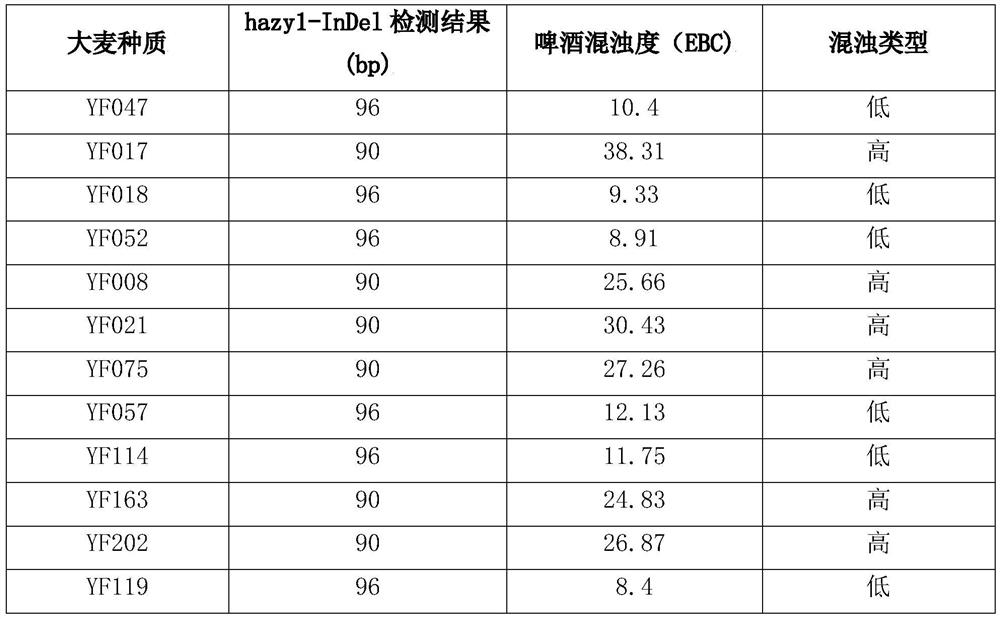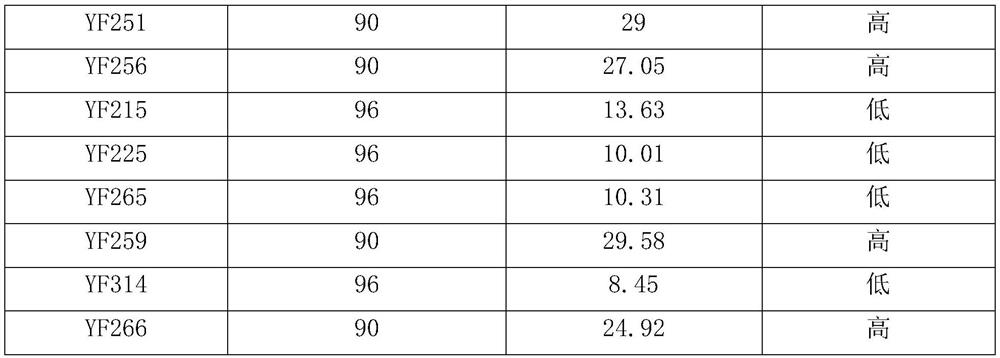InDel molecular marker related to barley beer turbid character and application thereof
A molecular marker and barley technology, applied in the field of molecular biology and genetic breeding, can solve the problems of huge seed quantity, cumbersome measurement and analysis, and difficult to be accurate and reliable results
- Summary
- Abstract
- Description
- Claims
- Application Information
AI Technical Summary
Problems solved by technology
Method used
Image
Examples
Embodiment 1
[0033] (1) Test materials
[0034] 120 DH lines constructed using both cultivated barley Franklin and Yerong were used as materials. The 120 materials were cultivated uniformly to harvest the seeds, dried and stored for later use.
[0035] (2) Character determination
[0036] The harvested barley seeds are subjected to mini-malting according to the following method: Weigh 200 grams of seeds, clean them, and then soak for 5 hours, 8 hours without water, 8 hours, 12 hours, 3 hours, and 1 hour at 15°C. Sprout again 82 hours later. After the germination is over, the drying process is carried out. After the dried malt was rooted, the winemaking experiment was carried out.
[0037] The wine-making test methods are as follows: (1) Weigh 50g of malt and smash it into 10 mesh size; (2) Saccharify the malt meal in a saccharification apparatus according to the protocol saccharification method; (3) Dilute according to the feeding ratio of 1:8; 4) Adjust the pH of the wort to about 5.4 with ph...
Embodiment 2
[0043] (1) Test materials
[0044] Twenty DH lines constructed using both cultivated barley Franklin and Yerong were used as materials, including 10 high-turbidity germplasm materials and low-turbidity germplasm materials, as shown in Table 1.
[0045] Table 1 20 barley germplasm materials with different turbidity characteristics
[0046]
[0047]
[0048] The CDS sequence alignment of the hazy1 gene of the above 20 barley materials showed that the CDS start site of the hazy1 gene of the low turbidity barley materials contained CCGCTG 70 bp downstream of the ATG, while the sequence of the high turbidity barley materials did not contain CCGCTG. .
[0049] (2) Acquisition of hazy1-InDel mark
[0050] According to the above 6bp deletion site, a pair of Indel labeled primers are designed, the upstream primer is 5'-CCGTCATGGTCTCCGTCTTC-3', and the downstream primer is 5'-AGTGTCCGAGCAGATTGGTC-3'.
[0051] (3) DNA extraction
[0052] Using fresh leaves at the seedling stage as materials, the CT...
PUM
 Login to View More
Login to View More Abstract
Description
Claims
Application Information
 Login to View More
Login to View More - R&D
- Intellectual Property
- Life Sciences
- Materials
- Tech Scout
- Unparalleled Data Quality
- Higher Quality Content
- 60% Fewer Hallucinations
Browse by: Latest US Patents, China's latest patents, Technical Efficacy Thesaurus, Application Domain, Technology Topic, Popular Technical Reports.
© 2025 PatSnap. All rights reserved.Legal|Privacy policy|Modern Slavery Act Transparency Statement|Sitemap|About US| Contact US: help@patsnap.com



